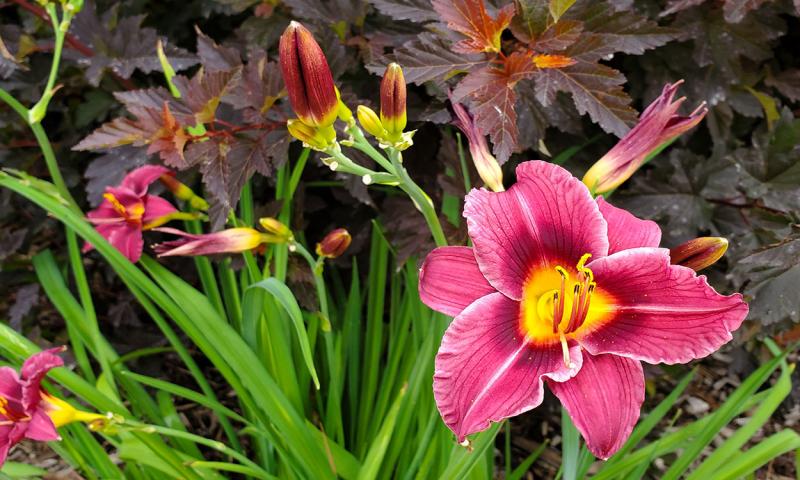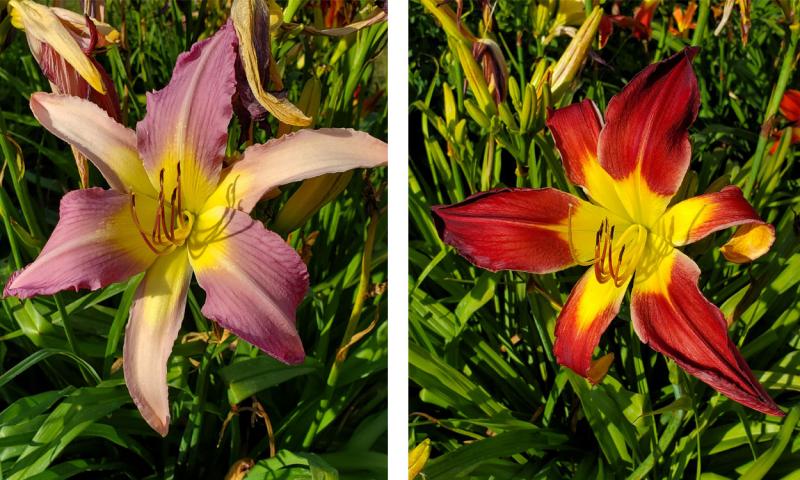
Original article by David Graper, former SDSU Extension Horticulture Specialist and Master Gardener Program Coordinator. Updated by Kristine Lang, Assistant Professor and SDSU Extension Consumer Horticulture Specialist.
Every July through August, one of our most-planted perennial flowers takes center stage with its wonderful display of flowers – the daylily. Daylilies (Hemerocallis) are one of America’s favorite flowers with good reason.
They are easy to grow and adaptable to just about any garden location. They tolerate poor soils, heat, and even short periods of drought once well established.
Appearance

Daylilies are made up of clusters of plants, or fans of foliage, each connected to its own root system, but also joined to the other plants in its cluster. The leaves look grass-like and range from about 15 to 30 inches in length. The V-shaped leaves are typically one inch wide.
Daylilies get their name from the fact that each individual flower is open for just one day. But usually each flower stem, known as a scape, will hold five to nine flowers, and multiple scapes may develop on each plant.
Flower stems can grow two to three inches tall, holding the flowers well above the foliage. Flowers are usually four to six inches wide with six petals. Flower color can range from white, yellow, pink, lavender, purple, orange, red and burgundy. Many daylily cultivars have interesting combinations of several colors along with wavy margins to the petals, colored edges or contrasting colors in the flower’s throat.
Varieties

There are several different species of daylily available, but hybrids have pretty much taken over markets and garden centers. New cultivars are being released every year. No matter your taste, there is probably a daylily out there that you would enjoy having in your garden.
Daylilies are a plant that many home gardeners use to make their own hybrid crosses. The male and female flower parts are large and easy to see, making cross breeding quite easy. Many plants will also readily produce seed pods and viable seed.
Care and Maintenance
Plant daylilies in a full-sun to partly shady location in well-drained soil. Spring is the best time to transplant or divide daylilies, but they are tough enough to withstand division just about any time during the growing season. Be sure to provide extra water during dry periods to help plants get reestablished. If you want to divide a large plant, you can either “cut out” a section, leaving most of the plant intact, or dig up the entire plant, separate it out into small clumps or fans, then replant in a new location. You can cut back the foliage to about half its length to reduce water stress during hot weather. More information can be found in our article, Dividing Perennials in the Spring.

Most daylilies will bloom in mid-summer then do not bloom at all the rest of the year, except for the occasional secondary scape that grows up. However, since the advent of the famous ‘Stella de Oro,’ one of the first reblooming daylilies, there are now dozens of different cultivars that will provide a longer season of bloom. Generally, this means that they will still have their largest display of flowers in early summer, but then sporadically produce additional flowers the rest of the summer until frost. Removing flower scapes after the flowers have faded (deadheading) will significantly increase the likelihood of getting more flowers. If you do not deadhead, the plant will be putting energy into producing fruit and seeds, instead of more flowers. When deadheading daylilies, cut the flower stem down low in the plant, so that an ugly stub is not left above the foliage.
Pests and Diseases
Daylilies have few pest or disease problems. The most-common insect pests are aphids and thrips. Forceful jets of water will usually dislodge the aphids, or you can use insecticidal soap following all label instructions for application. Thrips cause most of their damage in the flowers, where you will see whitish streaks in the colored parts of the flower petals. But you may also see damage to the leaves, usually near the mid-vein or bottom of the “V.” Their rasping-sucking mouthparts will cause silvery streaks in the leaves. Control of thrips is much more difficult, since most insecticides have little effect on them. But thrips will usually not cause serious or permanent damage to the plants.
Leaf streak is the most-common disease of daylilies, and it has been a fairly common problem during wet springs and summers. The disease starts out as small, dark-green spots along the mid-rib of the leaf. Soon these spots turn brown and enlarge, followed by the leaves turning yellow. The disease is caused by a fungus that overwinters on diseased foliage from the previous year. It spreads with rainfall or sprinkler irrigation. The best means of control is to avoid sprinkler irrigation and remove diseased leaves when they appear. Heavily infested leaves will produce sclerotia, a dark, seed-like overwintering structure, that allows the disease to survive through the winter. A thorough cleanup of the plants in the fall, after the foliage has been killed by freezing weather, can be of significant help in reducing the reoccurrence of the disease. Root and crown rots may also be a problem, but generally only if daylilies are planted in poorly drained soils.


